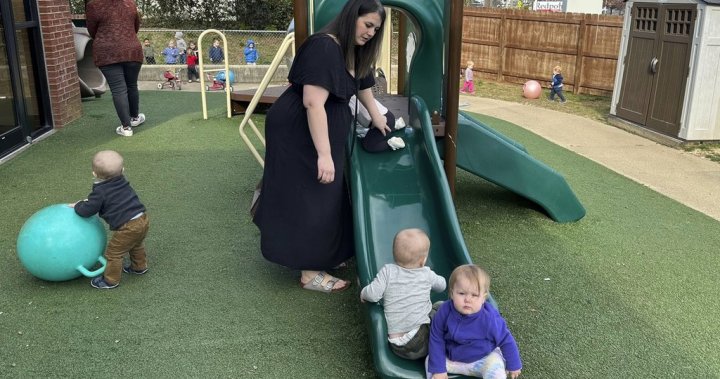A recent poll has revealed a striking shift in American priorities: the skyrocketing cost of child care is now a greater concern for U.S. adults than declining birth rates. The findings, published earlier this week, paint a picture of families grappling with immediate financial pressures, outweighing anxieties about the nation’s long-term demographic trends. The results underscore how immediate expenses outweigh concerns about societal trends.
The survey, conducted among a representative sample of over 2,000 adults nationwide, found that 63% identified affordable child care as a “very” or “extremely” important issue, compared to 48% who expressed similar concern about falling birth rates. This margin highlights the everyday strain families face in affording quality care while managing other essential expenses. A surprising statistic for those tracking demographic shifts and government reports.
Debate Overview → Key Arguments → Unresolved Questions:
The debate surrounding child care and birth rates has intensified in recent years, fueled by economic anxieties and changing social norms. Some argue that declining birth rates pose a significant threat to the nation’s long-term economic stability and social security system. Others, however, contend that addressing the immediate challenges of families , particularly the burden of child care costs , is paramount. This divide in concerns is also reflected in the different priorities of many families today.
Key Arguments:
- Affordability Crisis: The cost of child care often exceeds housing expenses for many families, especially in urban areas.
- Economic Impact: High child care costs force many parents, primarily women, to leave the workforce, reducing household income and overall economic productivity.
- Long-Term Demographic Concerns: Some experts believe that declining birth rates could lead to labor shortages and strain social security systems in the future.
- Quality of Care: Families also worry about the quality and safety of child care options available, adding to the stress of finding affordable solutions.
- Access Barriers: Availability, particulerarly for infant care or children with special needs, adds further complications.
Unresolved Questions:
- What are the most effective policy interventions to address the child care affordability crisis?
- How can we balance the need to support families with young children while also addressing long-term demographic concerns?
- What role should employers play in providing child care benefits to their employees?
- How can we ensure equitable access to affordable, high-quality child care for all families, regardless of income or location?
Sarah Miller, a mother of two young children in Ohio, expressed the frustration felt by many families. “It’s a constant juggle,” she said. “My husband and I both work full-time, and we’re still struggling to afford decent care. I know so many mom’s contemplating less hours to make it work. Another job that would cover daycare costs seems like such a dream for many.” Her comments highlight the very personal sacrifices parents are making in this trying economy.
The poll’s findings have spurred renewed calls for government action to address the child care affordability crisis. Advocates are pushing for policies such as expanded child care subsidies, universal preschool programs, and tax credits for families with young children. The administration has acknowledged the issue and pledged to propose solutions in the coming months, yet details remain sparse. A White House spokesperson stated, “The President understands the challenges facing working families and is committed to finding innovative ways to make child care more accessible and affordable.”
Economist Dr. Emily Carter, specializing in family policy, emphasized the broader economic implications of the child care crisis. “When families can’t afford child care, it’s not just a personal problem; it’s an economic problem,” she explained. “Parents are forced to make difficult choices that can limit their career opportunities and reduce their earning potential. This has a ripple effect on the entire economy.”
The concern about child care costs is not limited to any single demographic group. The poll found that it transcends age, race, and political affiliation, suggesting a widespread sense of economic anxiety among American families. Dispatches from various newsfeeds are reporting similar trends, especially on online forums and parenting groups.
However, some experts caution against dismissing concerns about declining birth rates altogether. Demographer Dr. James Thompson argues that while addressing the immediate needs of families is crucial, it’s also important to consider the long-term implications of declining population growth. “We need to find a way to support families now while also ensuring that we have a sustainable population for the future,” he noted. Some have taken to social media to express their worries. A user on X.com commented, “We can’t ignore the birth rate issue! Who will pay for social security if no one is having kids?” The discussion continues to rage across different platforms.
The challenge lies in finding a comprehensive solution that addresses both the immediate needs of families and the long-term demographic challenges facing the nation. This will require a multifaceted approach that includes investments in child care, family-friendly policies, and efforts to promote economic security for all Americans. One possible solution is for larger scale companies and corporate to provide subsidized childcare for the employees that require such support.
The poll also revealed a significant difference in perspectives between parents of young children and those without children. Parents were far more likely to express concern about child care costs (78%) compared to those without children (55%). This suggests that the issue is particularly salient for those who are directly experiencing the financial burden of raising young children. Social media sites like Facebook and Instagram are flooded with discussions on how to handle increasing child care costs.
The question remains: How will policymakers respond to this growing concern? The upcoming legislative session will likely be a crucial test of whether meaningful action will be taken to address the child care affordability crisis. One anonymous source familiar with the matter commented, “Several bills are being drafted, but bipartisan support remains uncertain.”
In rural communities, the struggle is often compounded by a lack of available care providers. Lisa Johnson, a single mother in rural Montana, shared her experience: “Finding quality, affordable child care out here is nearly impossible. I often have to drive over an hour each way to drop off and pick up my daughter, which eats into my work day. Suddenly, the landscape changed,” she recounted. “It felt like the world was moving on while I was stuck behind.” This feeling is widespread across communities like hers.
While debates continue, the reality for many families remains unchanged: The struggle to afford child care is a daily battle, often forcing them to make difficult choices that impact their financial well-being and their children’s future. Further surveys are sure to show an alarming and disheartening trend in this very importannt sector.



